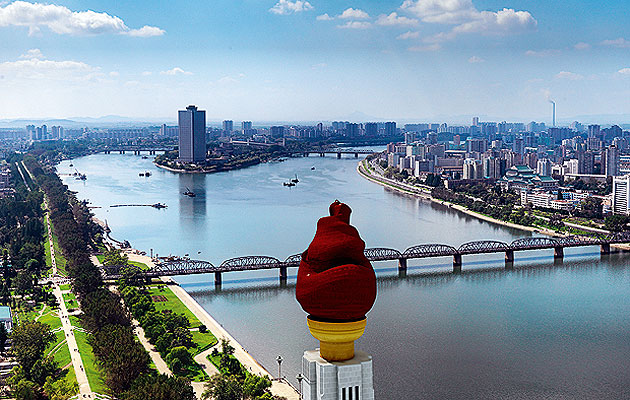|
|
||
|
Was Kim Jong-il a postmodernist? In his 1991 text On Architecture, the late North Korean dictator proposes integrating axial planning with modernity, functionality with decoration, new materials with old, and hierarchical, centralised planning organisation with public consultation – the latter because “the masses are the true critics of architecture”. This treatise on the principles of “Juche Architecture” is one of the many components of Architectural and Cultural Guide Pyongyang. It comprises two lushly illustrated volumes – one translation of an actual architectural guide to the North Korean capital and one book of analysis. It’s timely – the fascination with the remnants of Stalinism that has produced a score of glossy architecture books becomes the documentation of a very real and extant dictatorship, with its buildings fresh, and its streets clean and empty. Editor Meuser has form on this; his Capitalist Realism was a provocative book on the mutant Tsarist-Stalinist-Vegas style of contemporary Russia, and these volumes follow suit in looking, with relative objectivity, at an architecture shaped by the most repugnant forces. Although the extreme nationalism and cultishness of the North Korean state ideology Juche, usually translated as “self-reliance”, bears zero resemblance to Marx or Lenin (references to both were dropped from its constitution decades ago), the closest comparison is still the architecture of other “Marxist-Leninist” regimes. The first volume is mostly full of things that nobody would bat an eyelid at in today’s architectural press; the difference is the buildings aren’t ruined. The guide is handily divided into sections according to typology. The (rent-free) residential blocks mostly resemble the sheer concrete cliffs built everywhere in the USSR under Brezhnev, bar some dramatically curving, Niemeyer-esque high-rises. The Ice Rink or the May Day Stadium are close cousins of the futurist-baroque recently collected in Frédéric Chaubin’s CCCP (Taschen, 2011). The traditional-eclectic mishmash of the People’s Palace of Culture is more Maoist in derivation. The gigantic axial streets, usually ending in monuments, are an awesome and pointless neo-Haussmann film set, aided by a banal Parisian Arch of Triumph. The monuments tend towards more maniacal versions of, say, the Soviet Memorial Park in Treptow, Berlin. The Metro derives from Moscow or Baku, bizarre and dreamlike subterranean passageways full of mosaics and obsessively-designed chandeliers. So this is a magpie collection of authoritarian forms and styles, and hence isn’t terribly Juche. The Idea is communicated more in the dressing – the ubiquitous symbols, mosaics and murals, where Kim Il-Sung is a ubiquitous deity, and exhortation is constant. Nowhere can you find a single view of Korea’s tallest building, the Ryugyong Hotel, begun in the 1980s and still unfinished. The all-important second volume needs to add context and critique, which it does so only sporadically, preferring generalisations and many more pictures, including the notorious Shard-like hotel, a section on the famous “Mass Gymnastics”, and the aforementioned text by the late Leader. The most important of the essays is an informative essay by South Korean critic Ahn Chang-mo, which provides direly required historical context. There is, however, an essay by Christian Posthofen called “Learning from Pyongyang”. It’s a semiotic reading of Juche’s complex symbolism rather than an attempt to analyse or evaluate this unnervingly and interestingly non-capitalist landscape directly. It dialectically argues, with references to Barthes and Foucault, that city-dwellers could learn from Pyongyang’s unambiguous authoritarianism counter-techniques to resist power, which sounds a tad like post-facto justification for a guilty fascination. It predictably shies away from the more pressing question of whether rent-free mass housing or advertising-free streets could be extricated from famines and concentration camps. Architectural and Cultural Guide Pyongyang, edited by Philipp Meuser. Dom Publishers, £32. |
Image Foreign Language Publishing House, Pyongyang/Meuser/Dom Publishers
Words Owen Hatherley |
|
|
||



















